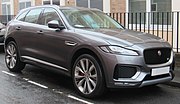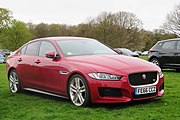Jaguar R and SVR models
This article relies too much on references to primary sources. (December 2019) |
| Jaguar R, Jaguar R-S/SVR | |
|---|---|
 | |
| Overview | |
| Manufacturer | Jaguar |
| Production | 1995 — present |
| Assembly | Jaguar Land Rover Automotive PLC Castle Bromwich Assembly |
| Body and chassis | |
| Class | Sports cars (S) |
| Layout | Front-engine, all-wheel-drive |
| Related | Jaguar XJ220 |




Jaguar R and R-S/SVR models are a range of high performance versions of certain car models from the British automotive marque Jaguar Cars, part of parent business Jaguar Land Rover. These cars primarily focus on enhanced "sport" performance. Jaguar began producing R models in 1995 with the introduction of the first XJR, and began producing R-S models in limited production numbers and input from Jaguar SVO (Special Vehicle Operations) with the introduction of the 2012 XKR-S. The R-S mark has since been replaced[1] by the SVR (Special Vehicle Racing) designation, which was first introduced on the 2017 Jaguar F-Type SVR, effectively making the XFR-S the last Jaguar SVO car not to carry the SVR moniker.
History[]
The 1995 XJR was powered by a supercharged 6-cylinder engine, the car produced approximately 322 horsepower. With the revamped line of engines, the powerplant would be based on an eight-cylinder engine with supercharger from 1997 to present. The 1997–2003 XJR produced 370 horsepower (276 kW) and 385 pound-feet (522 N⋅m) of torque, taking the car to 60 mph (97 km/h) in 5 seconds. The new aluminium bodyshell from 2004 to 2009 and increased power to 400 hp (298 kW) and enhanced computer systems decreased the time to 60 mph (97 km/h) to 4.8 seconds. Starting after year 2000, XJRs were equipped with Jaguar's CATS (Computer Active Technology Suspension), which helped firm up the ride in sporty driving without compromising comfort during day-to-day use.
The first XKR was introduced in 1997 and kept with the same power increases as the XJR except for after 2006 the power in the XKR was boosted to 420 hp (313 kW). The S-Type R had a short production run from 2003 to 2008, and came equipped with the same 400 horsepower (298 kW) supercharged V8 as the other R models. It was replaced by the XFR, featuring a 5.0 L supercharged V8 producing 510 hp (380 kW) R-S models were then added to the line up starting with the XKR-S in 2012 and later in 2014, the XFR-S. Both these cars produced 550bhp, boasting zero to sixty times of sub 4 seconds. With the introduction of the F Type R some two years later, the then-to-be called Jaguar F-Type R-S was renamed the F-Type SVR along with the all future special vehicle operation (SVO) vehicles within the lineup.[2]
Models[]
- Jaguar XFR 510 hp (380 kW) mid-size saloon[3]
- Jaguar XKR 510 hp (380 kW) coupé and cabriolet[3]
- Jaguar XFR-S 550 hp (410 kW) mid-size saloon[4]
- Jaguar XKR-S 550 hp (410 kW) coupé and cabriolet[3]
- Jaguar XJR575 575 hp (429 kW) full-size saloon
- Jaguar F-Type R 550 hp (410 kW) coupé
- Jaguar F-Type SVR 575 hp (429 kW) coupé
- Jaguar F-Pace SVR 575 hp (429 kW) SUV
S Models[]
Jaguar offers an "S" variant on many of their vehicles, which includes sportier styling on both the exterior and interior, more horsepower, and a firmer suspension.

Jaguar E-Pace R-Dynamic S

Jaguar F-Type S
References[]
- ^ "Future Jaguar performance cars to carry SVR badge instead of R-S".
- ^ "Jaguar Will Replace R-S Badge with SVR". 20 January 2015.
- ^ a b c "r_Specifications". Jaguar Cars.
- ^ "r_Specifications". Jaguar Cars.
External links[]
- Jaguar Cars
- Land Rover
- Official motorsports and performance division of automakers







